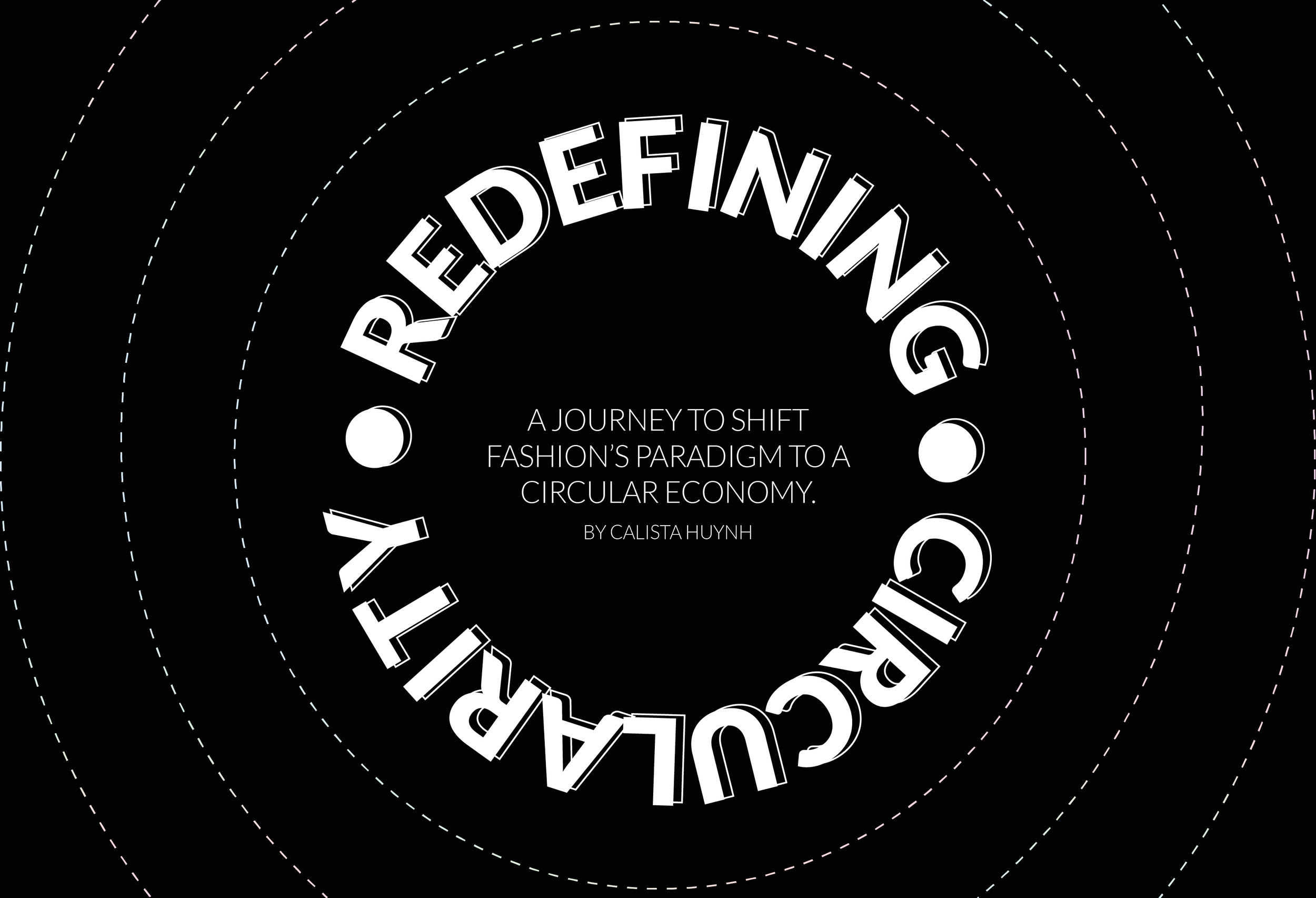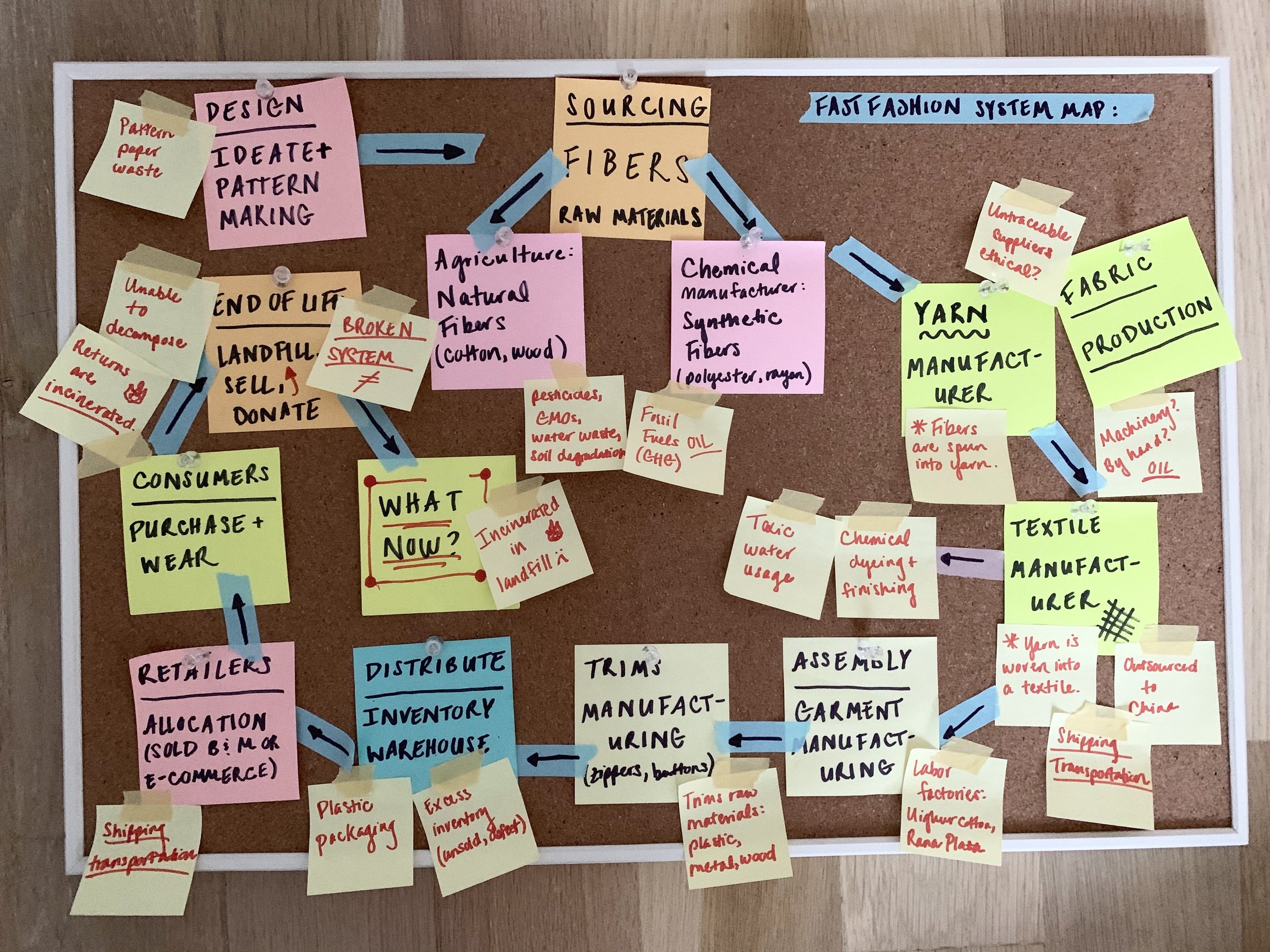Redefining Circularity
A journey to shift fashion’s paradigm to a circular economy
Skills: Circular Design, Design and Systems Thinking, Research & Development
THE CHALLENGE
When I entered my senior year, I began with an ambitious, never-done-before goal. I wanted to dismantle the entire fast fashion system and save the planet. At least, that's what I naively thought was the only solution. Well, it turns out the solution is a lot more complex than doing just that. And this preconceived assumption ultimately created more barriers and obstacles for myself as I continued my research journey.
I realized that the fast fashion paradigm is a colossal infrastructure that can not easily be taken down in one piece. And dismantling it would bring more consequences than good if not approached cautiously. In short, fast fashion will never die as long as consumerism ceases to exist. However, we can look at the entire fashion value chain that is often divided between pre and post-consumer and evaluate which areas produce the most environmental impact and are in need of innovation.
I started with this simple polarity between pre and post consumerism, believing I needed to focus on one area of the value chain. Which area would be more valuable for me to explore? I identified that there is a tension point between the pre and post consumer. Both are very different conversations, but are equally important that inevitably feed off of each other. One cannot exist or change without the other. What you change in one place, there will be a ripple effect to the entire cycle. That is when I shifted my direction from taking down fast fashion all together to help companies adopt a circular model that is regenerative and encourages consumers to extend their product’s life cycle.
KEY TAKEAWAY UNLOCKED: Through my research, I mapped out problem patterns and overlapping issues allowed me to see that there is a misconception behind what it means to be circular. Every expert I spoke with or listened to had their own definition and shifted blame on another party. Therefore, uncovering how there are so many more systemic issues that prevent a circular economy like government policies, greenwashing, and lack of proper disposal infrastructures. I identified that part of the problem stems from our perspective. We are so focused on fixing these individual issues that we don’t look at the bigger system as a whole. And what if we did? I decided to approach the fashion industry’s polluting impacts through a systemic lens.
APPROACH & PROCESS
The initial problem I wanted to solve was to take down fast fashion conglomerates. My hypothesis asked, “Addressing the key tension point between pre consumer and post consumer, how might we refunnel end of life cycle products back into the beginning of the supply chain in order to pivot to a circular economy?” However, I quickly discovered through my research that the expectation of existing companies to perform in an environmentally sustainable way isn't reasonable, nor an effective solution. Frankly, there are many deeper, systemic issues that prevent companies from entering the circular economy. Furthermore, the shift from a linear “take, make, waste” model to a circular business model is a hard and overwhelming process and I shifted my main goal to focus on tackling these root pain points and to develop a solution to support the transition to a circular economy.
The Three Ecologies by Felix Guattari
Down a Complex Path
I then looked at The Three Ecologies by Felix Guattari, the French post-structuralist philosopher and psychoanalyst. Guattari proposed The Three Ecologies: the Social (social relations), Mental (human subjectivity), and Environmental (nature) ecology. He proposes these ideas, “as strategies or processes towards a reconstruction of social and individual practices of ecosophy.” Believing capitalism’s power has infiltrated society by extending over all aspects of social, economic, and cultural life. If we continue this vicious cycle, it may threaten the continuation of life through individual and collective deterioration. I adapted this holistic way of thinking to the fashion industry. Every ecology proposes its own issues derived from capitalism and human desire. We can not reach true circularity until we can learn to break the ecology bubble we are currently stuck in. Ironically, we must break the existing cycle to achieve circularity. It pushes beyond figuring out how we can reuse a product or what type of plastic is used, rather examine how we can shift the system altogether through human behavior, choices, and actions. Or at least begin understanding how to with this thought process. True circularity does not lean solely on one party, but can only be achieved if we as humans shift our way of thinking and approaches.
“Addressing the key tension point between pre consumer and post consumer, how might we refunnel end of life cycle products back into the beginning of the supply chain in order to pivot to a circular economy?”
Introducing The Circular Model Canvas
This need led me to create the Circular Model Canvas (CMC). Inspired by the Business Model Canvas, this holistic framework reimagines the traditional business model into a circular one. I designed a tool that would challenge young entrepreneurs to apply these big picture ideas of what it means to be circular to their business and provide a personal roadmap for those who might feel overwhelmed with the concept.
In addition, I created an interactive resource hub for users who are curious to dive deeper into the canvas sections. The CMC Resource Guide provides links to examples and resources that users can refer to for guidance, clarity, and direction to better inform their prompt answers.
What is the mental impact of our product?
It is important to acknowledge the mental impact your product will have on your end user. This feeds into thinking about how your product’s greater impact will influence your end user’s identity as well as the purpose it has in their lives beyond generating profit.
What is the environmental impact of our product?
In the conversation of circularity, environmental consciousness is undoubtedly vital to consider. In this part, it’s not about having the right answers and it is getting a bit more complex but it’s more about unpacking your understanding of what goes into an eco-conscious process rather than getting all the right answers.
What is the social impact of our product?
It is time to bring the service component to life and think about who your external and internal partners are. This section recognizes your outreach and calls attention to your ehical behaviors. This acknowledges your communities and externalities your company might incur.









